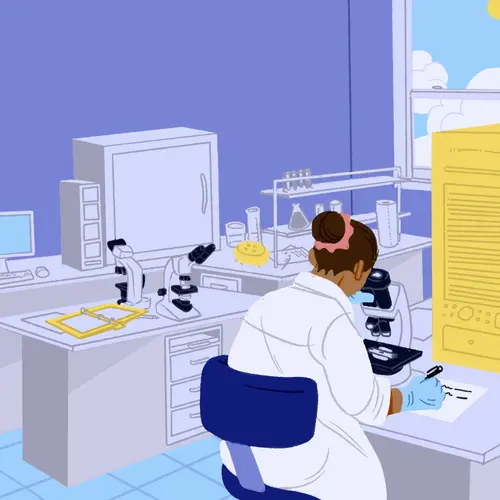There’s no approved treatment for geographic atrophy (GA). But experts are studying several types of treatments that may be available soon.
In the meantime, there are some things you can do to protect your eyesight and see better as your vision changes.
Get Help from Health Care Providers
With GA, cells and blood vessels in your retina start to die, and that area of your retina thins. This process is called atrophy. This leads to vision loss in the center of your vision, or when you look straight ahead.
While there’s no medical treatment that can regrow these cells, you can get help from medical professionals that may help you see better.
AMD Treatments
Even though there’s no treatment for GA, your doctor may recommend treating your age-related macular degeneration (AMD) to slow its progression and help save the eyesight you still have.
If you have a type of AMD called wet AMD, your doctor may recommend an injection with an anti-vascular endothelial growth factor (anti-VEGF) drug or ANG2. These meds block your body from making or inhibiting a protein called VEGF, which produces new blood vessels. By slowing or stopping blood vessels from developing, it may slow down your vision loss.
You might try photodynamic therapy (PDT) to treat your AMD. In this technique, your doctor uses a laser and injects a light-sensitive drug to destroy extra blood vessels in your eye.
Your doctor may recommend nutritional supplements that combine vitamins and minerals like beta-carotene, copper, lutein, vitamin C, vitamin E, zeaxanthin, and zinc. Research suggests this may slow down the progression of a type of AMD called dry AMD.
Even with these AMD treatments, symptoms often come back. And there are risks, including cataracts, eye infection, retinal detachment, severe vision loss, and structural eye damage.
Implantable Miniature Telescope
If you have near or distance vision, your doctor may talk to you about an implantable miniature telescope. This is a small telescope that a doctor puts into your eye. It replaces your lens and magnifies images.
It’s not an option for everyone, so talk to your doctor.
Low Vision Rehabilitation
Seeing a low vision specialist can help you make the most of the vision you still have and hold on to your independence.
A low vision specialist can give you skills and strategies to see better and manage your daily activities. For example, they may train you to use your peripheral vision, which usually isn’t affected by GA.
They may also give you vision aids to help you see better, like magnifiers and raised tactile dots, or bump dots, to put on things like microwave buttons so you can feel for them instead of looking for them.
Vision Aids
Small adjustments like better lighting, magnifying aids, and reading devices can make your daily life with GA easier.
You can try vision aids like:
- Adaptive aids like bump dots that help you feel for things you’re looking for
- Auditory devices so you can listen instead of look, like a talking watch or a voice recorder to hold your shopping list
- Closed-circuit TVs that magnify your screen
- Large-print reading materials like books, magazines, and newspapers
- Magnifying devices
- Special computers, tablets, and software
- Special lights and lighting
- Telescopic lenses to help you see in the distance
Lifestyle Choices
You can create healthy habits to protect your eye health. This may help you hold on to the eyesight you have now.
Try these healthy lifestyle choices:
- Exercise regularly.
- Follow a healthy diet with omega-3 fatty acids and antioxidants. Eat more dark leafy greens, fish, and whole grains.
- Get regular dilated eye exams.
- If you smoke, quit now.
- Use an Amsler grid, which helps you monitor your vision from home and find out if it’s getting worse.
Upcoming Treatments
While there’s no approved treatment for GA available, the future looks bright. There are many studies and scientific projects happening now that are studying ways to manage, treat, and prevent GA.
Pegcetacoplan. This is a new drug that’s in development. Clinical trials suggest it may slow the progress of vision loss when you have GA. The FDA is reviewing pegcetacoplan now and experts expect an answer soon. If the FDA approves it, it will be the first treatment for GA in the U.S.
Complement inhibitors. Experts are looking at a group of drugs called complement inhibitors. These medications ease your immune system response, which may help treat GA. An example of a new complement inhibitor is an oral drug called danicopan. Clinical trials are looking at how safe and effective danicopan and other complement inhibitors may be. Avacincaptad pegol is another complement inhibitor being reviewed by the FDA for treatment of GA.
Geographic atrophy lipoic acid. One clinical trial is testing a once-a-day antioxidant and iron chelator pill called geographic atrophy lipoic acid (GALA). Researchers are testing it to see if it slows the growth of GA.
Stem cell replacement. Researchers are studying cell replacement to see if it helps with GA. They grow cells on plastic sheets and then, through surgery, place them under your retina and unroll them to get them in the right position. The cells seem to hold up well, for at least a year. So far, a few people have tried stem cell treatments.
You can find more information on clinical trials for GA at clinicaltrials.gov and antidote.me.

